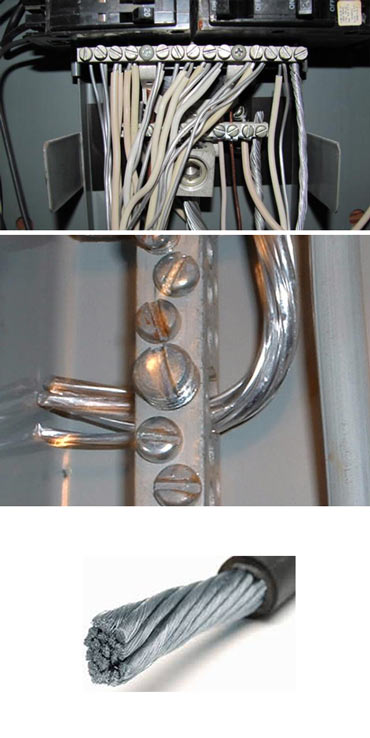
Residential Property Inspection
Aluminum Wiring



Home Inspection - Aluminum Wiring
by Garet Dennis
History
Most electrical wiring is copper. In the early 1960's the price of copper began to rise and aluminum wiring was commonly used for residences from the mid-1960s through the mid-1970s. There are several million homes in the US with aluminum branch circuit wiring.
The Problem
There is no problem with the aluminum wire itself within the walls; the problem is at the connection points. First, aluminum expands and contracts more than copper when it heats and cools. This can cause fasteners to loosen. More importantly, aluminum oxidizes easily and the oxide is a poor conductor. This causes overheating at the connection points (the main source of trouble). A further problem with some aluminum wire is fatigue. The wire becomes brittle and breaks if bent back and forth only a few times. Do not to pull outlets and switches out of the wall to examine them yourself. Leave this to a qualified licensed electrician who can fix any problems that might be found.
The Result
These problems can create overheating and arcing at connection points which have led to fires resulting in injury and deaths. Research sponsored by the Consumer Product Safety Commission (CPSC) shows that homes wired with aluminum wire manufactured before 1972 are 55 times more likely to have one or more connections reach "Fire Hazard Conditions" than are homes wired with copper.[1, p.2] "Post 1972" aluminum wire is also a concern. A change in the aluminum wire alloys in 1972 did not solve all of the problems.
The presence of aluminum wiring can almost always be detected during a standard home inspection. However according to Dr. Jesse Aronstein "The probability of aluminum-wired connection overheating in a home varies considerably according to the types of connections, the installation methods used, and the circuit usage, along with many other factors."[2, p.1]
Problems with connections are not normally visible on the face plate. You need to check every connection throughout the house to know if a hidden problem is lurking somewhere (this is not included in a standard home inspection). Even if the home inspector does not report any other problems with the aluminum wiring it is prudent to consult with a licensed electrician who is thoroughly familiar with aluminum wiring problems for a more extensive evaluation. A standard home inspection is only a first step in reducing risk.
The Solution
Currently, only two solutions have been recommended by the CPSC.[1] The first solution is to replace the aluminum wiring with copper. Sometimes this is possible, such as a house with a full crawl space and attic, or a house with wiring contained inside conduit. But in most cases re-wiring with copper is likely to be cost prohibitive and impractical unless you plan on extensive remodeling.
The second solution uses a special crimp connection to splice a short piece of copper wire (called a pig-tail) between the aluminum wire and the electrical device (receptacle, switch, light, etc.). This connection can only be made using a special crimp-type connector made by the AMP Corporation (the COPALUM connector). Proper use of this method requires specialized training, and it's only available to licensed electricians.
Another method that has recently become available is the AlumiCon connector. In closing, remember that any repair work should be performed only by a licensed electrician thoroughly familiar with aluminum wiring.

Federal Pacific Electric Panels
Grandfathering and Building Codes
